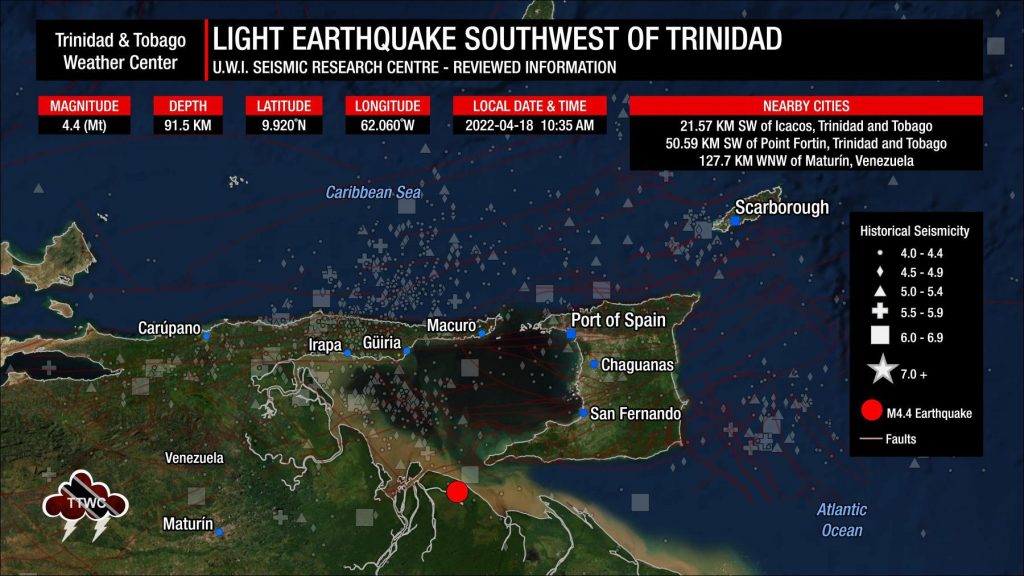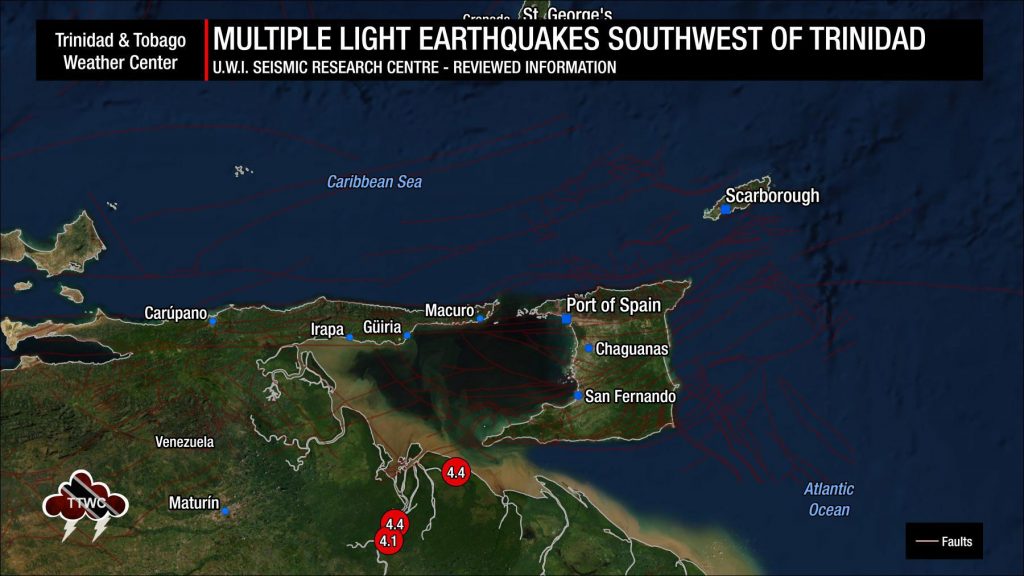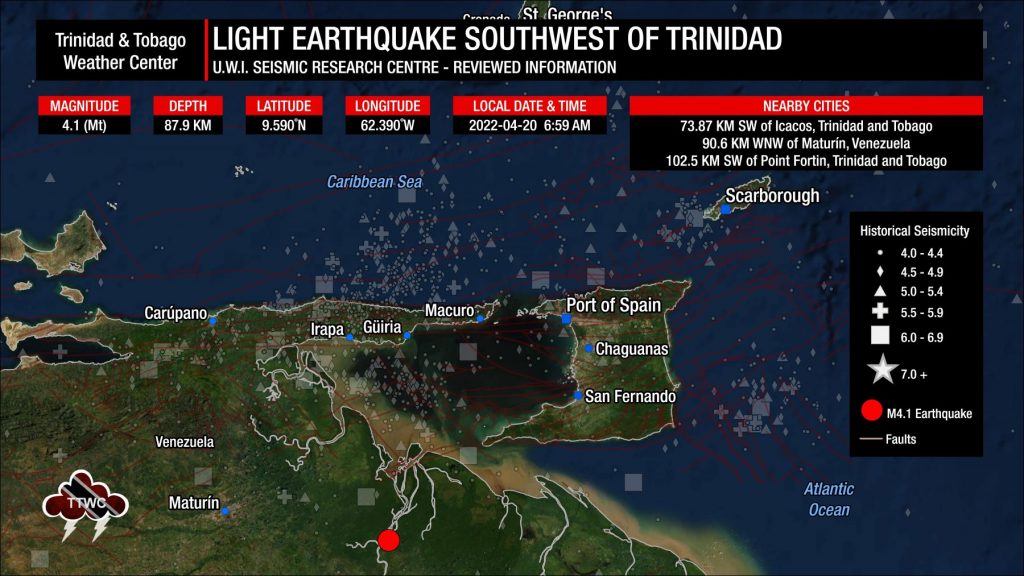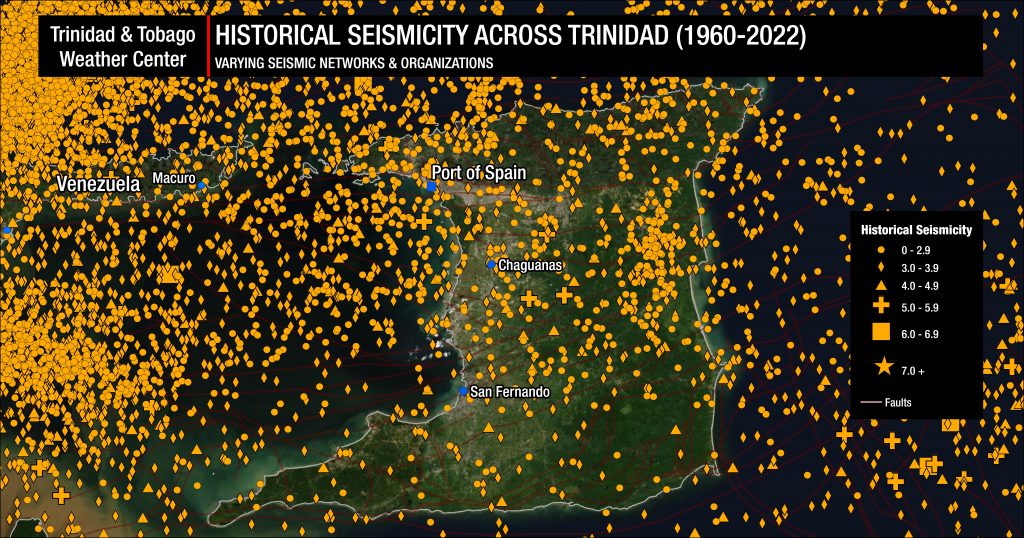On April 18th and April 20th, the University of the West Indies Seismic Research Centre (UWI SRC) recorded three light (M4.0+) earthquakes southwest of Trinidad. Quakes in this particular area are not very common.
The First Quake

At 10:35 AM Monday, April 18th, 2022, a light magnitude 4.4 (mt) earthquake occurred approximately 21.57 KM SW of Icacos, Trinidad and Tobago, 50.59 KM SW of Point Fortin, Trinidad and Tobago, and 127.7 KM WNW of Maturín, Venezuela. This event was located at 62.060°W and 9.920°N, at a depth of 91.5 kilometers according to the UWI SRC.
Two More Quakes Strike Less Than 48 Hours Later

Less than two days later, the area was jolted by two other light quakes further southwest compared to Monday’s event. The first occurred at 3:48 AM on April 20th, registering a magnitude of 4.4 (mt) approximately 65.3 KM SW of Icacos, Trinidad and Tobago, 94.2 KM SW of Point Fortin, Trinidad and Tobago, and 92.8 KM WNW of Maturín, Venezuela. This event was located at 62.360°W and 9.670°N, at a depth of 102 kilometers according to the UWI SRC.
The second event of the day occurred just under four hours later at 6:59 AM according to the UWI SRC. That quake registered a magnitude of 4.1 (mt) approximately 73.87 KM SW of Icacos, Trinidad and Tobago, 90.6 KM WNW of Maturín, Venezuela, and 102.5 KM SW of Point Fortin, Trinidad and Tobago at 62.390°W and 9.590°N. The event was located at a shallower depth of 87.9 kilometers according to the UWI SRC.

To date, none of the recorded events have been reported felt. You can submit felt reports to the University of the West Indies Seismic Research Centre.
There was no tsunami threat.
There are four conditions necessary for an earthquake to cause a tsunami:
- The earthquake must occur beneath the ocean or cause material to slide within or into the ocean.
- The earthquake must be strong, at least magnitude 6.5.
- The earthquake must rupture the Earth’s surface and it must occur at a shallow depth – less than 70 kilometers below the surface of the Earth.
- The earthquake must cause vertical movement of the seafloor (up to several meters).
None of these conditions occurred.
Note that different seismic monitoring agencies use different methods, or several methods, for processing quake parameters across the globe. Each method has its limitations and will likely produce different results within the range of the data’s uncertainty. This is generally accepted within the scientific community.
This zone, south of Trinidad, is fairly seismically quiet. Russo et al. (1993) defined this zone as a passive margin edge in the Foreland Basin in the north of South America, covering events with strike-slip and mixed thrust and thrust around the Orinoco-Delta region in Venezuela with an average depth of 50 kilometers and a maximum magnitude of 6.5. Generally, we see episodic moderate (M5.0-M5.9) earthquakes.
According to the SRC, during the instrumental period since 1952, there has been negligible seismicity generated in the zone closest to Trinidad. However, the Amacuro Delta in eastern Venezuela periodically generates earthquakes above magnitude 5.0.
Within 20 kilometers of these three earthquakes, based on the UWI SRC’s solutions, 113 other quakes have been recorded since records began. The largest event in recent history occurred on October 13th, 1969 at a magnitude of 4.6, though it was estimated a magnitude 6.5 quake struck within the 20-kilometer radius on December 23rd, 1945. Generally, seismic events in this location, south of Trinidad, have occurred at depths between 0 and 151 kilometers, with most events located at depths shallower than 50 kilometers.
Has there been an increase in seismic activity?

Trinidad and Tobago and the surrounding region are very seismically active. Across the Eastern Caribbean, over 2,200 earthquakes are recorded annually. Since 1990, the University of the West Indies Seismic Research Centre records an annual average of 280 earthquakes in the Trinidad and Tobago region (area bounded by 9.5°- 11.5°N & 59.5°W – 63.5°W). Of these 280 quakes, 50 of these seismic events are, on average, above magnitude 3.5.
Most earthquakes occur northwest of Trinidad in an area known as North of the Paria Peninsula, which has the second-highest seismicity in the Eastern Caribbean. According to the UWI SRC, approximately 65 events of magnitude 2.1 and above are located in the area annually.
However, the UWI SRC has said regional seismic and volcanic activity has been elevated for several years in their annual report for 2020 to 2021.
On average, the Eastern Caribbean has seen a pattern of major (M7.0-M7.9) quakes every 20 to 30 years. That pattern has stayed true. The last major (M7.0-7.9) quake occurred north of Martinique in 2007.
Historical patterns indicate that great quakes (M8.0+) on the Richter Scale have occurred every century in the region. The probability of another event at that level is high since the last >M8.0 earthquake occurred in 1843. While it is impossible to say definitively when the next great quake would occur in the region, the time since the last one is now more than 170 years ago.
It is important to note seismic activity *cannot* be predicted – meaning the precise time, date, magnitude, depth, etc., cannot be known ahead of time based on current research and technology.
Now is the time to create or go over your earthquake preparedness plan and know what to do during, before, and after an earthquake.









